With spring
![]() Capos attached from the side
Capos attached from the side
With spring
Capos of this type are fast, but not adjustable. Tension is determined by the thickness of the neck.
| Spiral Frame Capo Schuster & Co was a mailorder company in Markneukirchen / Kingenthal, Germany. They made instruments until worldwar II. This spiral spring capo is from their catalogue, around 1920. |
| Here is the real thing - a beautiful and clever design. The bar is hinged
in the center of the spiral brass frame. The end of the bar is hinged to a neck
protection, slideable on the frame. When attaching it to the instrument neck, the capo is
tightened by rotating the frame around the capo by pulling the hook end of the frame. In
the drawing above the capo is tightened. [Owner: James Westbrook, The Guitar Museum, England.] |
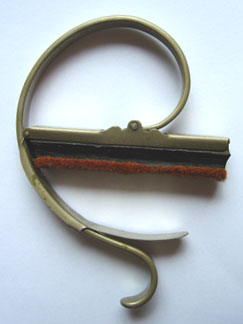 |
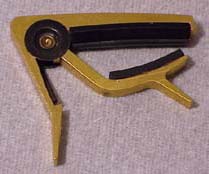 |
Kyser Torsion spring capo made of aluminum profiles. This concept was based upon Berner's observation of one of his wife's snap clothespins. The patent was licensed to Kyser in about 1985 or 1986 by Berner. US patent 1979 by Nichols, Berner & Fernandez (France). |
| Dunlop
Trigger At about the same time Nichols sold the above patent to Jim Dunlop - without Berner's or Fernandez's consent (!). Dunlop made a more refined version with a soft, rounded pad. US patent 1979 by Nichols, Berner & Fernandez (France). |
|
Now, both Kyser and Dunlop had contracts on the same patent!!
|
|
Kyser Quick-Change Instead of fighting over the rights to the 1979 patent, Kyser made another design based upon the same torsion spring idea. They obtained a new patent to cover the changes. US patent 1986 by Charles B Powell, Jr. |
| Soft, rounded pad. The scroll is for decoration and better grip. Some versions have an extra hole in the scroll that can be used for prying the bridge pins out when you change strings. |
|
Kyser Quick-Change Partial capo, leaving the 6'th string open.
|
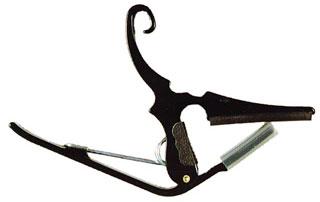 |
|
|
Kyser Quick-Change Partial capo leaving the 6'th, 2'nd and 1'st strings open.
|
|
 |
Modified Kyser This clever modification for partial capoing was invented in 2008 by Jacob Jackson, Indiana. The rubber pad is replaced with a velcro strip. Six small pads for capoing individual strings can be fastened as desired on the velcro. For storage of the pads not in use, velcro is also glued on top of the capo . |
Kyser K-Lever
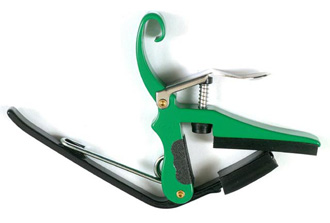
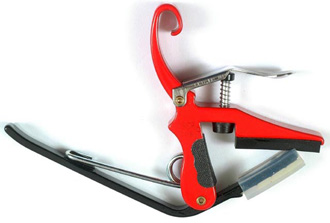
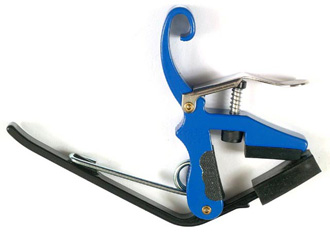
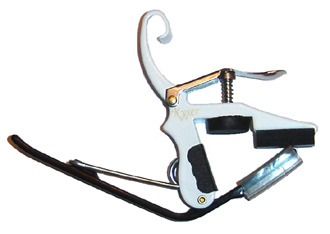
| With the lever on these partial capos you can fret the string/strings left open by the capo by pressing down the lever. Green is Drop D, red is Double Drop D, blue is DADGAD and white is Open G. Invented by Greg O'Haver, Indiana. |
| Galli Gun-Capo Plastic variation of the
Kyser Quick-Change. This capo uses a spiral spring though. Comes in many colors. |
| Unknown Kyser copy where the top handle seems to be made of plastic. |
|
Copley Another Kyser copy. |
|
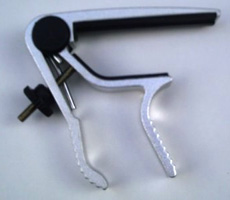 |
Here is a copy of the Trigger capo, improved with a stop screw preventing the capo from closing too much. This will shorten the distance between the handles. |
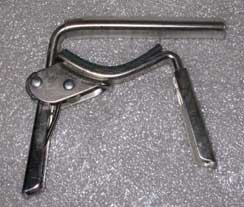 |
Cejilla COCODRILU A spanish made Trigger copy. [Owner: Philippe Saint-Pierre, France.] |
| Cejilla Samba A spanish made spiral spring capo, shurely inspired by the Trigger capo. [Owner: Philippe Saint-Pierre, France.] |
| Fender Spring Capo Another torsion spring capo, cleverly bent out of one single piece of heavy spring wire. |
| Wilkerson Here the spring itself presses against the back of the instrument neck. Tension is applied and released with the sleeve lever. The pad is seated in a slot, very easy to change. US patent 1980 by James W Wilkerson. |
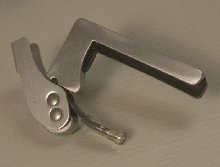 |
 |
Liberty
Bringe Aluminum banjo capo. Leather padding is not original. |
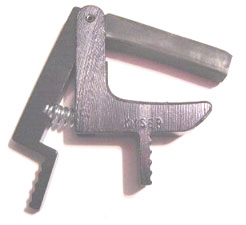 |
Kyser Banjo Capo The capo above was pretty tough to open. Kyser put handles on it, but it's not marketed anymore. |
It took over three years, from when I first heard of it, until
I was able to present the next
spectacular capo in the capomuseum. Thanks Rick Shubb for helping me!
| Digital Capo This cool, plastic capo has a
very realistic molded finger on the bar so it looks as though you have grown an extra
finger! (In English the word digit is another word for finger.) Four
versions were offered. There was a man's finger, a woman's finger (much more delicate) and
they were each available in either "Caucasian or Negro skin tones". Here is the story told by Bob Wiley himself:. |
|
| . "I molded my finger for the straight and curved male black and white capo, and the dentists office secretary where the amalgum molds were made, was the model for the female versions. To manufacture the capo's, I went to a place in Wichita, Kansas called KETCH. This is a wonderful organization that specializes in training mentally and physically handicapped individuals. They quoted a very competitive price for assembly and packaging of the capo. The box it came in acted as a counter display, in that you could open the box, place the capo into the center of the box, and it looked just as the capo looked on the neck of a guitar. The Digital Capo was very "tongue in cheek" and if you read the back of the box it came packed in, there is a story I made up regarding the history of the capo. Of course it is entirely untrue." |
 |